If you’re in the market for a platform that will help you manage your XR fleet, there’s a pretty good chance that you’ve come across ManageXR. It’s one of the few dedicated XR MDMs and has gained quite a bit of traction in the industry.
However, it’s not the only solution out there.
If you’re looking for other great alternatives, this ArborXR guide has you covered. We’ll walk you through a few reasons why you might want to look for an alternative, then introduce six of the top ManageXR alternatives for all kinds of use cases.
What Is ManageXR?
ManageXR is an MDM built to help businesses manage XR (AR, VR, and MR) headsets and experiences. Its user-friendly dashboard allows for easy device management, control, and content deployment at scale.
Remote Content Installation.
With ManageXR, you can easily send content, apps, and updates to multiple XR devices at once using a simple remote dashboard.
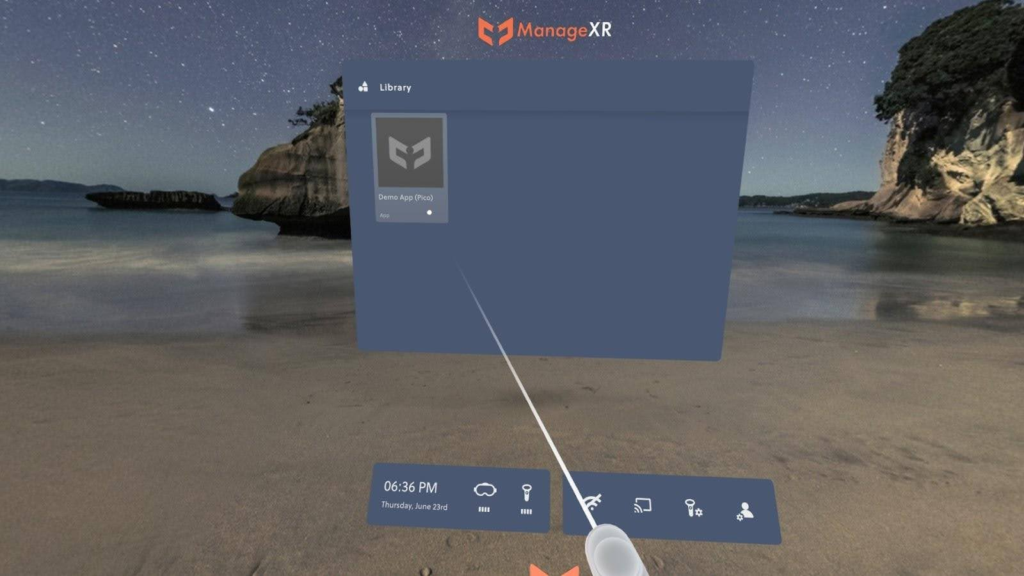
This means you don’t have to deal with messy cables or load content by going through each device one by one.
Device Configuration
With ManageXR, you can configure all your devices remotely, ensuring each one is perfectly tuned for its specific purpose—whether it’s for training, education, or something else entirely.

Here are just some of the key features that make this possible:
- Batch Configuration: Apply settings to multiple devices at once—perfect for managing large fleets.
- Network Management: Configure WiFi Network profiles remotely.
- Security Policies: Add safeguards like passwords and app restrictions to keep your devices secure.
Customizable Home Screen
The ManageXR Home Screen lets you customize the appearance of your XR devices to match your branding, including logos and colors. You can also restrict users to specific apps and settings, preventing them from exiting without a PIN.
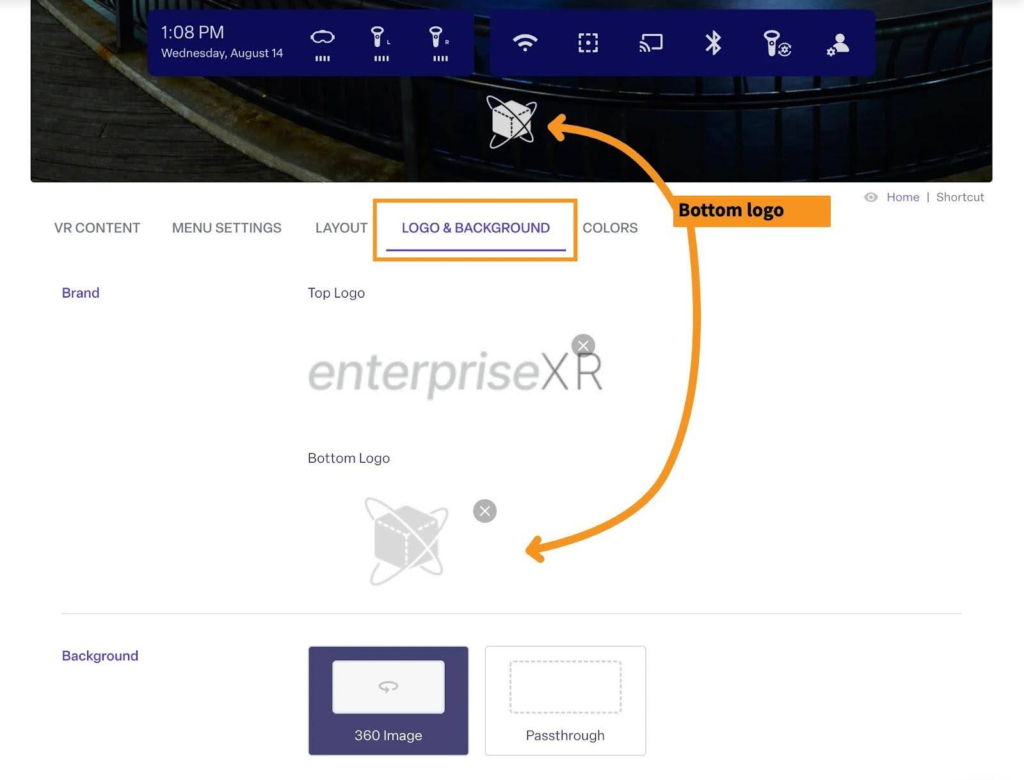
However, the platform does not support custom 3D home environments, which limits its ability to deliver a fully immersive experience.
Why Seek an Alternative to ManageXR?
Right off the bat, ManageXR is a solid product. Its features are well-designed, and the team is constantly working to improve them for their customers. But there are a few things to keep in mind:
Emerging Player
ManageXR is relatively new to the XR management market. While its features are helpful, you may want to explore more established platforms with a stronger track record, especially if your organization is making substantial technology investments.
Not a Full Enterprise Solution
ManageXR might not meet the needs of larger enterprises that require a more comprehensive and integrated solution. If you’re scaling complex XR initiatives, a platform with stronger industry recognition and enterprise-level features might be a better fit.
Lacks Some Key XR MDM Features
ManageXR is missing a few key features that are pretty important when managing XR devices. For example:
- Nested Groups: It doesn’t let you organize devices into sub-groups for more precise control.
- Custom S3 Storage: There’s no option to use custom Amazon S3 storage for content, which limits your flexibility in managing data.
- Cloud Compatibility: ManageXR only supports Google Cloud, so if you prefer AWS or Azure, you’re out of luck.
- Remotely Wiping App Data: It lacks the ability to remotely erase app data from devices—a feature that’s crucial for security and compliance.
…and the list goes on.
6 Best ManageXR Alternatives
- ArborXR
- VMWare Workspace ONE
- Microsoft Intune
- SureMDM
- Quest for Business
- JAMF
1. ArborXR
ArborXR is a powerful, enterprise-ready XR MDM solution that makes it easy to manage VR, AR, and MR devices at scale.
We offer a simple, scalable platform that allows you to:
- Manage all your headsets in one place (remotely)
- Install and update apps at scale
- Deliver single- and multi-app kiosk experiences
…and more.
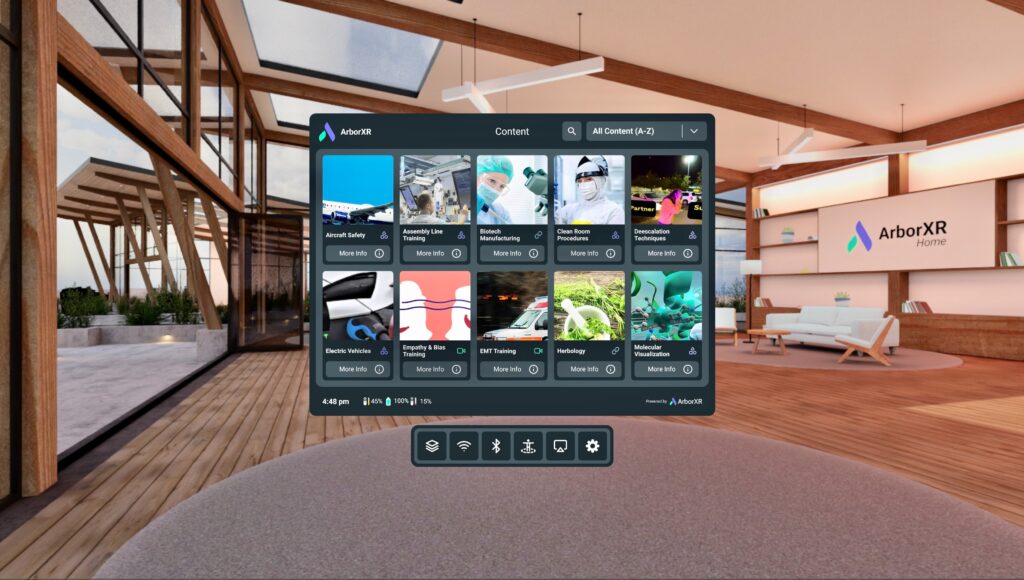
Since 2017, ArborXR has been trusted by 3,000+ global companies, including 50+ Fortune 500 businesses, to successfully implement and scale XR projects. Beyond technology, ArborXR offers guidance to help organizations avoid pitfalls and maximize their XR investments.
One standout feature is ArborXR’s dedicated customer support. As Jarrad Nagel, Senior Manager of Digital Learning and Innovation at Walmart, notes:
“One of the big reasons we’re working with ArborXR is I know I can get on the phone tomorrow with someone from their team and work through a problem or share a need. That’s rare and incredibly valuable to us.”
Plus, ArborXR is Qualcomm’s preferred MDM, solidifying our role as industry leaders trusted by top tech innovators.
Key Features
- Nested Groups: Organize devices into groups and sub-groups for more efficient content distribution and management.
- Custom 3D Environments: Create branded 3D home environments to enhance user engagement and reduce VR motion sickness—a feature unavailable in ManageXR.
- VR Single Sign-On (SSO): Allow users to log in with their organization’s credentials directly within the headset—a feature unavailable in ManageXR.
- Device Management: Remotely manage your devices’ settings, location, and battery levels. You can also push updates and control multiple devices simultaneously.
“Our enterprise customers can more effectively than ever manage large amounts of devices in their IT infrastructure, opening new opportunities. ArborXR has been a great tool for our team in managing events, allowing us to prepare hundreds of headsets in a fraction of the time compared to the hours it would cost in the past.”
Mark Cowles, Marketing Director at VR Expert
- Experience Management: Control user interactions in VR by remotely launching apps, monitoring what user is seeing in headset, or rebooting devices.
- Content Management: Deploy, update, and manage apps across multiple XR devices from a single dashboard. We also allow you to build and manage your content library in ArborXR, so you don’t have to manually link APKs
- Single and Multi App Kiosk Modes: Lock down users to a single app with kiosk mode, or multiple apps using ArborXR Home. You can also create a custom, branded, and immersive 3D home environment with ArborXR Home
- Analytics: Track device and app usage to make informed, data-driven decisions.
Pricing
ArborXR offers a 30-day free trial, after which you can choose from several pricing plans depending on whether you are a business or an educational organization:
- Business Plans:
- Starter Plan: $7 per device/month (billed annually).
- Essential Plan: $10 per device/month (billed annually).
- Enterprise Plan: $13 per device/month (billed annually).
- Education Plans:
- Starter Plan: $4 per device/month (billed annually).
- Essential Plan: $6 per device/month (billed annually).
- Enterprise Plan: $10 per device/month (billed annually).
Pros
- Simple, intuitive interface
- Offers guided support for content selection, implementation, and more
- Trusted by 3,000+ organizations including many enterprise leaders, including Fortune 500 companies like Walmart and Bank of America and top universities like Stanford, Harvard and MIT.
- Compatible with headsets from top brands like Meta, Lenovo, HTC Vive, and PICO
2. VMware Workspace ONE
VMware Workspace ONE is an intelligence-driven unified endpoint management (UEM) solution that allows you to manage and secure your devices, applications, and data across your organization.
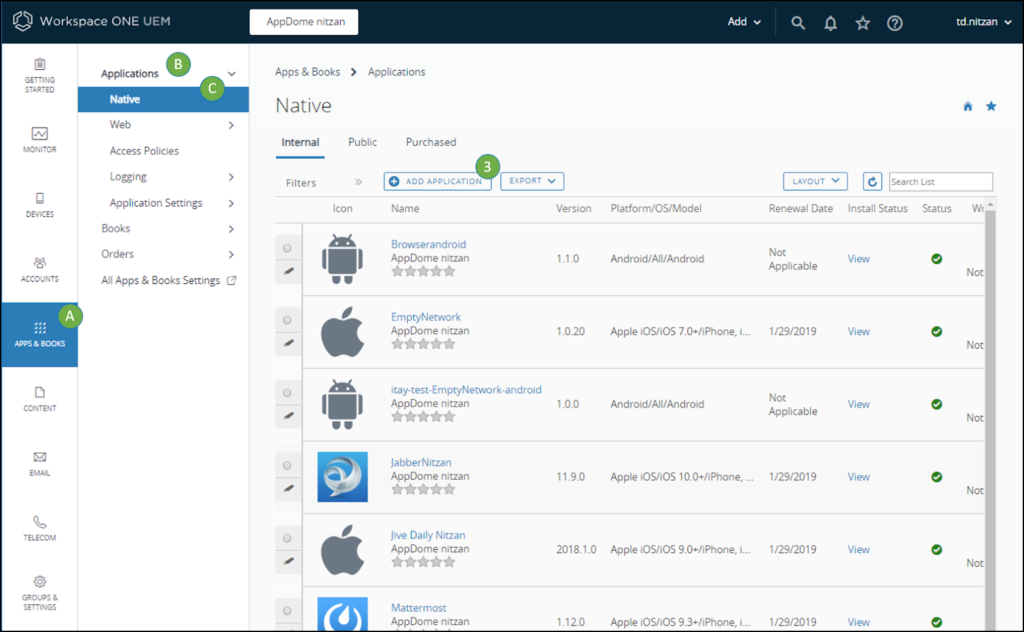
Unlike ManageXR, it’s not built specifically for XR devices. That means while you can use it with phones, tablets, desktops, and so on, it doesn’t have the XR-specific features you might be looking for. That said, it is a solid UEM that deserves a mention.
Key features
- Quest for Business integration: an official 3rd party MDM for Quest for Business
- XR Hub: A dedicated application within Workspace ONE that acts as the central launchpad for XR applications on VR headsets, providing a customized user experience and secure access to corporate content
- Device Management: Workspace ONE UEM allows for enrollment, configuration, and management of XR devices, including app deployment and security policies
- Shared device support: a must have in the context of corporate owned XR devices
Pricing
VMware Workspace ONE offers a range of pricing tiers based on your organization’s needs:
- Employee Essentials: $3 per user/month.
- Mobile Essentials: $5.40 per user/month.
- Desktop Essentials: $7.20 per user/month.
- UEM Essentials: $9.45 per user/month.
- Enterprise Edition: $15 per user/month.
Pros
- Supports both XR and non-XR devices
- Familiar interface, if you already use it to manage other devices
- Well-suited for large-scale deployments
Cons
- Limited content management features (i.e., no version management and release channels, no real-time visibility on installation status)
- No remote view for XR devices
- Complicated to use
3. Microsoft Intune
Microsoft Intune is a cloud-based UEM solution that helps organizations manage and secure their devices, apps, and data across various platforms—Windows, iOS, Android, and macOS.
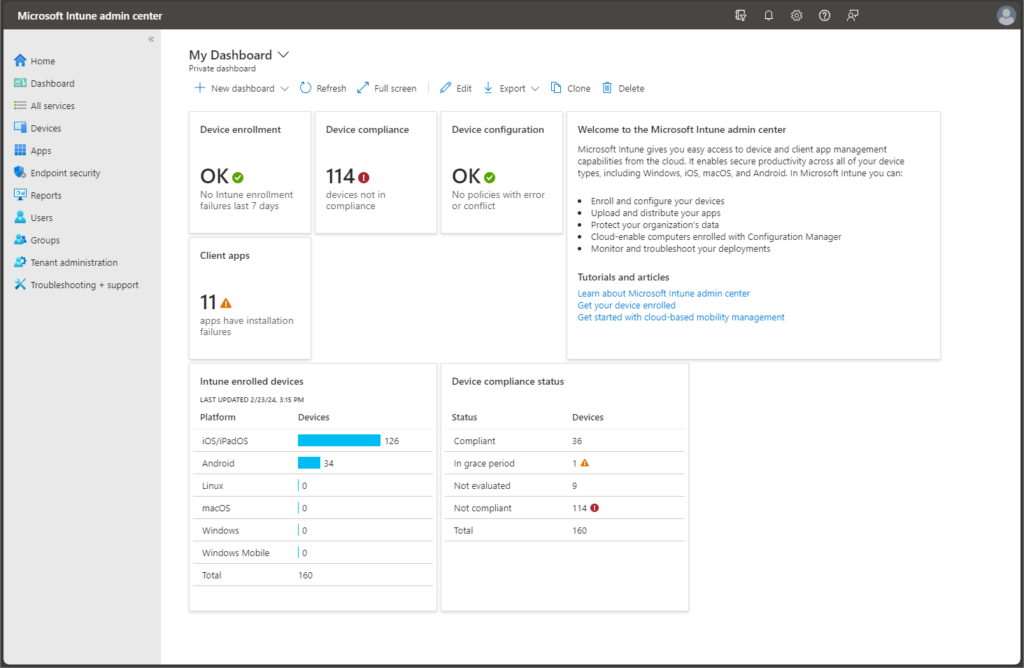
Intune is particularly suitable for enterprises that already rely on the Microsoft ecosystem and want a unified solution for managing both XR and non-XR devices.
Key Features
- Remote Management: Manage devices from anywhere by locking, restarting, locating, or restoring them remotely to maintain security and compliance.
- Mobile Threat Defense: Integrate with mobile threat defense services to scan for potential threats, detect malware, and automatically address vulnerabilities.
- Compliance Management: Enforce rules such as password policies, firewall requirements, and minimum OS versions to keep devices secure and compliant.
- Integrate with Quest for Business: Intune is another official third-party MDMs for Quest for Business.
- Shared Devices Support: Easily manage corporate-owned XR devices used by multiple employees.
Pricing
Microsoft Intune offers a free trial, followed by three primary pricing tiers:
- Plan 1: $8 per user/month.
- Plan 2: An additional $4 per user/month.
- Microsoft Intune Suite: $10 per user/month for more advanced features.
Pros
- Integrates seamlessly with other Microsoft products and services.
- Provides extensive security controls to protect against cybersecurity threats.
- Scales effectively from small businesses to large enterprises.
Cons
- Limited content management features (i.e., no version management and release channels, no real-time visibility on installation status)
- No remote view for XR devices
- Steep learning curve
4. SureMDM By 42Gears
Here’s the last UEM on our list—SureMDM.
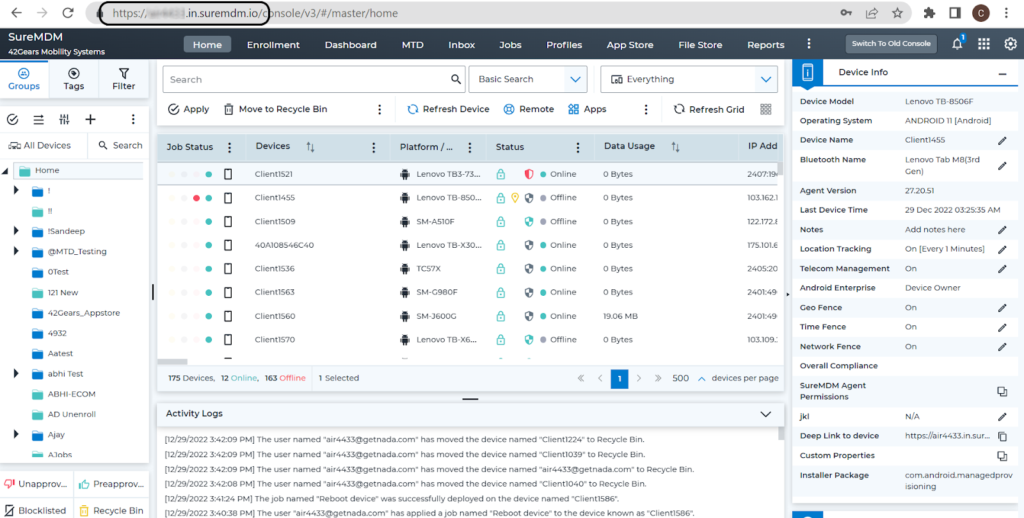
Similar to the previous tools, SureMDM helps organizations manage, monitor, and secure a range of devices—from smartphones, tablets, and laptops to a limited selection of XR devices.
Key features
- Remote Device Management: Update software, track device location, troubleshoot issues, and configure settings remotely without physical access.
- Application Management: Deploy, update, and remove apps across multiple devices simultaneously.
- Remote File Downloading: Download important files, like log data, directly from a device’s file system over Wi-Fi for quick analysis and troubleshooting.
- Data Wipe: Erase data remotely from lost or stolen devices to protect sensitive information.
Pricing
SureMDM offers three pricing plans, billed either monthly or annually:
- Standard Plan: $3.99 per device/month (billed annually) or $4.99 per device/month (billed monthly).
- Premium Plan: $5.49 per device/month (billed annually) or $5.99 per device/month (billed monthly).
- Enterprise Plan: $7.99 per device/month (billed annually) or $8.99 per device/month (billed monthly).
Pros
- Versatile device support
- Powerful remote support and troubleshooting features
- Responsive customer support
Cons
- UI is not as polished as some enterprise-grade solutions
- Limited content management features (i.e., no version management and release channels, no real-time visibility on installation status)
- No remote view for XR devices
5. Quest for Business
Quest for Business is a first-party MDM, built specifically for managing their Meta Quest VR headset. Put simply, it helps you manage your headsets, control the user experience, and deploy content on a large scale.

You can use Quest for Business as a standalone MDM or integrate it with third-party MDMs like VM Workspace One or Microsoft InTune for more functionalities.
Key features
- Device Management: Control all Quest headsets from a central dashboard—install apps, push updates, and remotely wipe devices as needed.
- Enterprise-Grade Security: Protect sensitive information with built-in security features designed for business use.
- Casting: Mirror the headset’s view onto a computer to monitor the VR experience in real time.
Pricing
Quest for Business is available with 12 months of free access when purchasing a Quest headset. After the initial period, pricing is:
- $14.99 per device/month
Pros
- VR-specific management tools and security measures
- Streamlined deployment process for Quest devices
- Meta first party solution
Cons
- Limited to Quest devices, no ability to manage other headsets
- A lightweight MDM, so it lacks the full range of features you’d expect from an enterprise MDM like ArborXR. For instance, it doesn’t offer custom home environments, remote app launching, release channels, or a dedicated content library.
- Relatively expensive
6. Jamf
And finally, there’s Jamf.
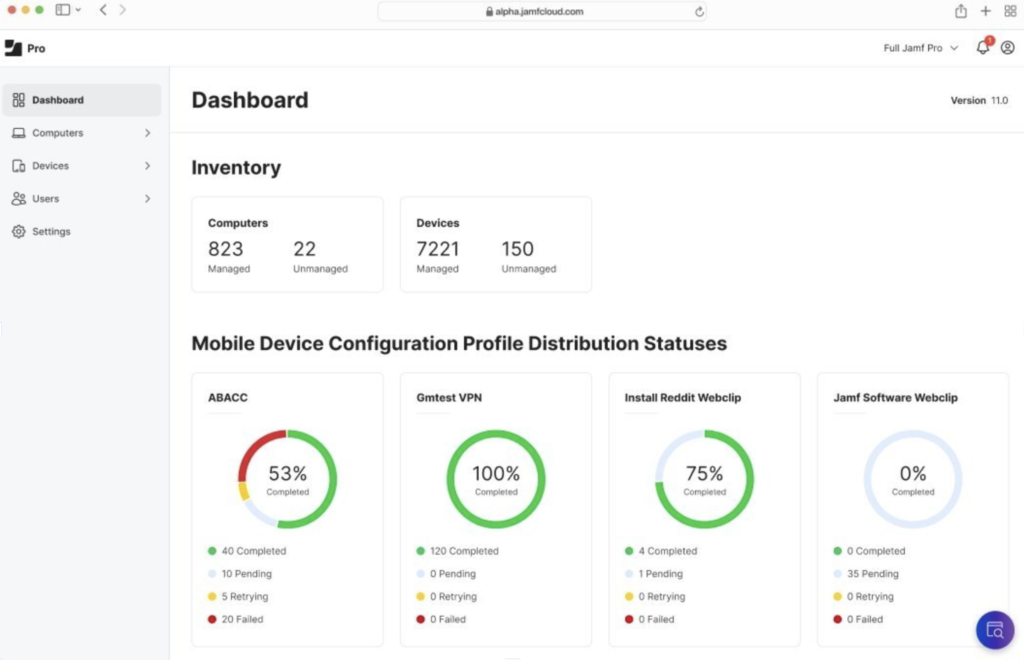
Jamf is a first-party MDM designed to manage all Apple devices—from iPhones and iPads to XR devices like the Apple Vision Pro. If your organization is deeply rooted in the Apple ecosystem, Jamf is definitely an option to consider.
Key Features
- Zero-Touch Deployment: Automatically set up and configure XR devices remotely, minimizing time and resource investments.
- App Management: Deploy and manage both App Store and custom XR apps across all managed devices.
- Configuration Profiles: Push specific configuration settings for XR apps and device preferences across your fleet.
- Inventory Management: Track and manage XR devices alongside other Apple devices within the same system.
Pricing
Jamf has a tiered subscription pricing model:
- Jamf Now: $4 per device/month.
- Jamf Business: $14.34 per device/month.
- Jamf Enterprise: Pricing is available upon request.
Pros
- Offers fast and efficient large-scale deployment
- Supports self-service
- Seamless integration with existing Apple device workflows
Cons
- Only Apple Vision Pro
- Not compatible with Meta, Pico, Lenovo or other popular VR and AR headsets
Get the Best XR Management With ArborXR
ManageXR is a strong choice for XR MDM, but it’s not the only one. If you’re considering alternatives, this article highlights six great options worth checking out—most notably, ArborXR.
ArborXR provides a reliable platform to help you remotely manage all your XR devices, install and update content, and control the XR experience at scale. Plus, we offer hands-on support and guidance to ensure your XR projects are set up for success.Want to see ArborXR in action? Sign up for free and experience a better way to manage XR initiatives.